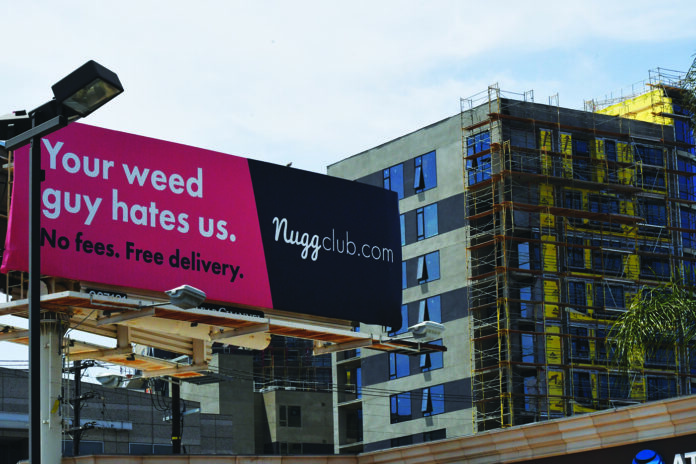The events of 2020 fundamentally altered consumer behavior and, in turn, the cannabis industry. To be fair, we knew last year would be transformative for marijuana. Half a dozen states had introduced ballot initiatives to decriminalize or legalize recreational and/or medical use. Support had increased on the federal level as well. With a presidential election on the horizon, talks of sooner-rather-than-later federal legalization hung in the air, generating both hope and trepidation.
There’s no doubt COVID-19 changed the world as we knew it. But responsive, adaptable entrepreneurs can capitalize on new shopping habits and carve out their share of consumers in new and established markets while avoiding potential pitfalls. Here’s what to know and why out-of-home advertising will play a key role.
Changes in consumer behavior
As the pandemic upended the economy, it also prompted the cannabis industry to rise to the occasion. Cannabis entrepreneurs moved to innovate and alter their business models to meet shifting consumer trends and mounting demand for cannabis products from edibles and oils to dog treats, skin care, and beyond. Regional stay-at-home orders coupled with a previously existing shift away from in-person shopping led consumers to no-contact ecommerce and delivery options. It doesn’t look like this shopping shift is going anywhere.
As long as customers remain happy with their digital shopping experiences, demand for pick-up and delivery services will grow. If you haven’t already, now is the time to invest in ecommerce and delivery channels. Third-party partnerships are one way to break into the market, but it is also worth considering owned and operated options that keep you in the driver’s seat when it comes to controlling customer experiences and data. This way you can ensure good consumer experiences from the start of an online order to the moment of delivery.
Compliant advertising
Once you’ve established a good customer shopping experience, how do you build brand awareness and acquire new customers? To be honest, it’s no easy task. Cannabis advertising channels are limited. With marijuana still illegal at the federal level, brands cannot advertise in or on mediums regulated by federal agencies. So, radio and television ads are off the table. Common digital media channels offering display ads, paid search, and paid social advertising are out as well. The likes of Google and Facebook also generally are out of the cannabis advertising realm. Even if digital ads are accepted on platforms, they typically come with caveats and complex restrictions. With such constraints, where’s a cannabis marketer to turn?
Out-of-home (OOH) advertising––think billboards, bus benches, wallscapes, and the like––is the single mass media option available to cannabis brands and businesses, and it offers an array of unique benefits. For starters, it’s cost-effective. This is especially helpful for early-stage brands focused on building credibility among potential customers. OOH is stitched into the fabric of communities. From large, stately billboards to street-level signage, OOH advertising has a legitimizing effect that can help brands expand their reach, build relevance, establish brand safety, and impact potential consumers without the constant hum of noise and negative content present on digital media platforms.
Shifting laws and regulations
While OOH is less restrictive than other media channels, it hasn’t been the simplest advertising platform to leverage. This comes down to the patchwork of advertising regulations cannabis marketers have to navigate not just from state to state, but also from county to county and municipality to municipality. Some states that allow medicinal use have barred cannabis advertising in any medium. Others create buffer zones that black out cannabis marketing near schools, places of worship, playgrounds and libraries, among other locales.
The intricacies (or, let’s be honest, inconsistencies) of advertising regulations have gotten only more complex. Voters in New Jersey and Arizona recently voted “yes” to legalizing marijuana for adult use. In Mississippi, voters approved a measure legalizing medical marijuana, while South Dakotans legalized cannabis for both recreational and medical uses. While many states haven’t yet established advertising regulations, it’s vital for brands to keep a watchful eye on the laws and regulations in their market(s).
To get started, keep in mind laws vary, even across city boundaries, and rapidly—and sometimes frequently—change. Fortunately, brands don’t have to do the legwork themselves. Experts in the niche can identify cannabis-friendly OOH units and start creating legally compliant ads to drive people to websites, apps, and storefronts.
With growing consumer demand and new markets opening across the nation, the opportunities for cannabis brands to leverage OOH advertising to reach current and prospective customers are abundant in 2021.














[…] As more states legalize recreational and medicinal marijuana and legislators eye legalization on a federal level, cannabis entrepreneurs are poised to see a sharp increase in opportunities to grow their businesses. As it stands, legal cannabis sales grew 46 percent in the United States last year with sales surpassing $17.5 billion, according to the Colorado-based cannabis research firm BDSA. That’s up from $12.1 billion in 2019. And by 2026, BSDA forecasts U.S. sales to reach up to $41.3 billion. So, with the cannabis space opening up around the country, what’s one of the best ways for businesses to reach new customers? Out-of-home (OOH) advertising. […]